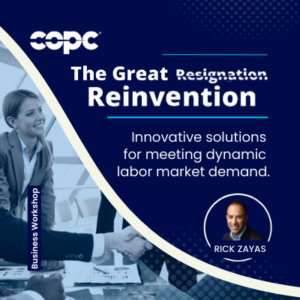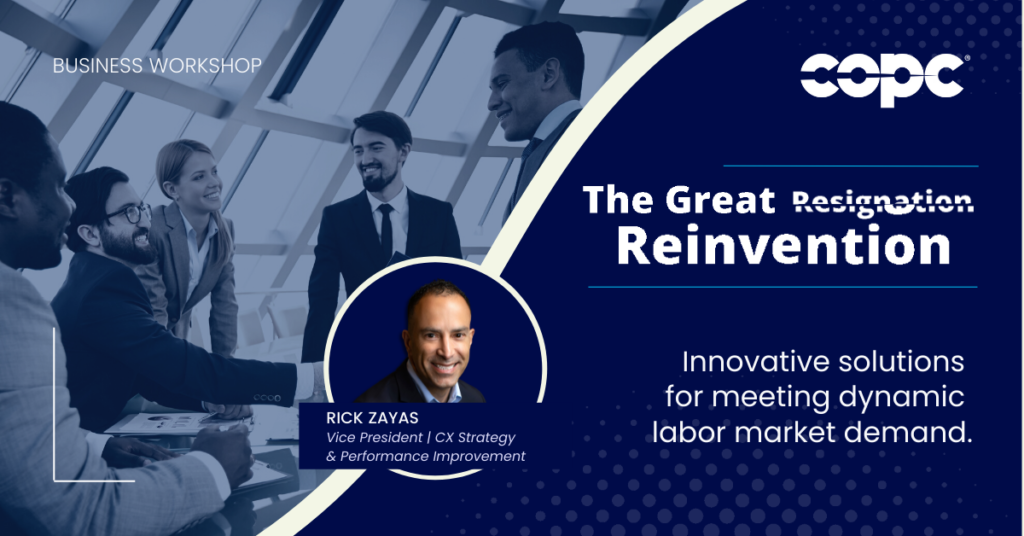
March 11, 2022
Prepare to lead your organization through a tough labor market with:
- Insights into key drivers affecting labor markets
- Best practices & approaches to reinvent labor policies
- Ideas on how to better manage/leverage outsourced service providers
- Changes for attracting & retaining the best talent to meet service levels
_________________________________
Most leaders are beginning to recognize the current labor challenges aren’t temporary or solely pandemic driven. The Great Resignation has made it significantly more challenging for many US firms to retain good talent and fill open positions.
Contact centers have not been immune to this phenomenon as traditional contact center roles have been drastically affected. Attrition and recruiting difficulties are not new to contact centers, and strategies to combat this have been developed and honed over the years.
But for some reason, this time, it feels different. This time, traditional retention and recruiting strategies don’t seem to have the same success level for some organizations. Why is this? And what can customer support operations do to begin to solve the current challenges of the labor market?
To begin solving any problem, we must clearly define and understand the root causes. Once we know the causation, we can formulate and pilot solutions. Research firms, recruiting experts, universities, employers, US Labor Statistics, and other data sources have identified several contributing factors behind the Great Resignation.
Significant labor market trends may be the primary cause of a particular contact center’s hiring and retention challenges. However, there is still a possibility that labor issues are unique to that call center. We recommend conducting a study to identify and confirm your specific drivers to know for sure.
More Jobs than Workers
The main driver of labor challenges is the simple fact that there are millions more job openings than people looking for a job. According to the US Bureau of Labor Statistics, there were 10.9 million job openings in the US in February 2022 compared to 6.3 million unemployed persons. This gap creates a vacuum that favors the average US worker and makes it difficult for employers to attract new talent and hold on to good workers.
A job market where skilled labor has the upper hand allows workers to reflect on how satisfied they are with their current job and employer. Workers have more options, and their talents are in high demand! You’ve probably considered changing careers during the past two years, or maybe you did.
A recent article by the HR Network referred to the Great Resignation as the Great Reassessment. HR network said, “It takes a significant or traumatic event like a pandemic or world war to get people questioning their lives and how work fits into it.” Well, I think we can all agree that the pandemic, wars, and social unrest over the past two years qualify as “significant or traumatic events.”
What existing criteria are prospective employees using to evaluate customer support roles, and how does your organization measure up? Limeade’s research found that people primarily changed jobs for:
- higher compensation
- flexible work schedule
- work-life balance
- ability to work remotely
 How well do your organization’s customer support roles compare against these criteria? Typically, contact center jobs don’t offer much flexibility, and compensation is at or near minimum wage — especially for staff with less tenure.
How well do your organization’s customer support roles compare against these criteria? Typically, contact center jobs don’t offer much flexibility, and compensation is at or near minimum wage — especially for staff with less tenure.
What differentiates your organization’s customer support roles to stand out in today’s hyper-competitive labor market?
The Big Gig
Multiple data sources [1] [2] [3] indicate that anywhere from 9% to more than one-third of US workers participate in the gig economy either as a primary or secondary source of income. We can expect gig economy participation to grow over the next five years, with projections of more than 50% of US workforce participation.
It’s an understatement to say that the gig economy has completely disrupted the landscape of traditional jobs. While gig jobs bring certain benefits to workers and businesses, they’ve also created a new challenge for conventional employers with traditionally designed roles.
Many gig jobs offer workers the ultimate flexibility regarding which gigs to accept, when, where, and how long they work, plus a choice of available compensation rates. Although gig workers generally don’t earn as much as full-time workers annually, gig jobs offer other perks such as quick or immediate compensation for performed services. In fact, according to the Pew Research Center, the majority of gig workers “rely on this income to meet basic needs.”
Most gig workers are from lower to middle-income brackets, as are many customer support workers. The availability of gig jobs, their flexible nature and access to near-immediate compensation have created real competition for customer support operations seeking to fill open positions and retain existing staff.
Gig jobs allow workers to explore other opportunities or career types, cover gaps in employment, and influence modern expectations of job design. It may be time for customer support organizations to rethink conventional job models like compensation and schedule flexibility. To compete with the gig economy, we can investigate granting quicker access to trying new roles or performing multiple jobs both in and outside the operation.
How much are you willing to change your customer support roles to better compete with gig job advantages?
Generational Preferences
One of the largest and fastest-growing portions of the US workforce is Gen Zers, who share many job preferences with younger Millennials. These job, career and employment tendencies existed before 2020 but have intensified by the past two years’ events.
Gen Zers and Millennials challenge workplace norms as they seek jobs with more flexibility and personal meaning [4] [5] [6]. They want to work for companies with progressive values, benefits designed for more than the traditional family, fair pay and gender equity, and a genuine social conscience for regional and global issues.
Flexible work schedules, working remotely and trying different roles are essential. This age group prefers training and development models that leverage mentoring and one-on-one coaches over traditional larger group classroom training approaches.
With a growing percentage of the US workforce comprised of Gen Zers and younger Millennials, how have your customer support roles evolved to keep up with their preferences?
What are you willing to change about your customer support roles to meet what Gen Zers and younger Millennials value in a job, career and employer?
Reimagining Customer Support Roles
Companies face new and ever-increasing challenges in recruiting and retaining skilled workers for customer-facing roles. Although the Covid-19 pandemic forced most customer support teams to transition to a work-from-home model, many customer support jobs are similar to those of a decade ago. Evolving worker preferences, a highly competitive labor market, and other factors require serious consideration for restructuring these roles.
